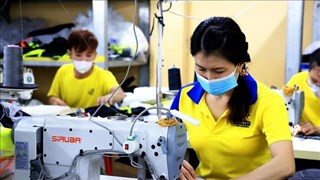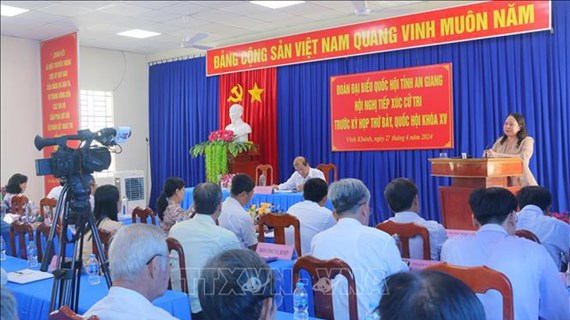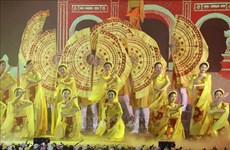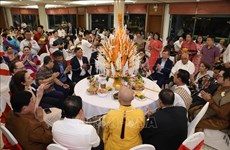Long Tong, unique farming ritual of the Tay
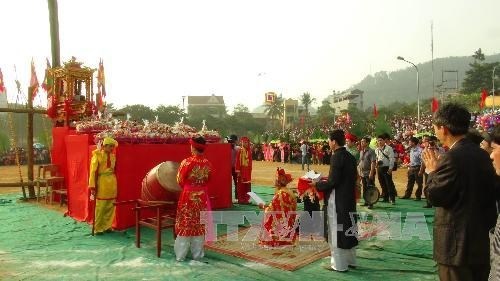 A ritual practiced in Long Tong festival in Tuyen Quang province (Photo: VNA)
A ritual practiced in Long Tong festival in Tuyen Quang province (Photo: VNA)Hanoi (VNA) - Long Tong (going to the field) is the most typical agricultural festival of the Tay, a big ethnic minority group living in the northern mountain region with a population of over 1.6 million.
Celebrated annually between the 1st and 15th days of the lunar new year, the festival is a religious ritual dedicated to the god of agriculture to win his blessing for verdant crops and prosperity for villagers throughout the year.
Held in a large harvested field in the middle of the village, Long Tong requires major preparations before the lunar new year. Families in the village are assigned different duties, the most important of which is preparing the offering tray. The offerings include a boiled capon, a boiled pig head, some grilled fish, two plates of sticky rice dyed red and yellow, and two cons.
Con is a
small ball made from pieces of colourful cloths sewn together and stuffed with
puffed rice and cotton seeds. Con is also decorated with gaudy cloth
tassels.
Long
Tong consists of three main parts: offering ritual which
includes a water procession, ploughing ceremony and folk game playing.
On the lunar New Year’s Eve,
representatives of families join the village head in a procession to take holy
water from a stream to the village shaman’s home. Representatives of families
also take the holy water in a dry gourd to their homes.
Before Long Tong, each
family in the village contributes a bamboo tree to set up a worshipping altar
in the selected field. The altar, which is erected in U-letter shape with the
bottom of the letter U facing the east, has a roof made of leaves. It also has
an arching gate made from two tree branches, on the top of which is hung a
drawing of tiger skin in red and yellow.
In the field a con pole
is also set up, which is a tall bamboo tree with a ring of about 40 centimeters
in diameter on its top. The ring is covered with a sheet of red paper at the
side facing the east, which symbolizes the sun, and a sheet of yellow paper at
the other side as the moon. On the pole is tied with a tree branch, which
symbolizes the pole’s life.
On the 5th of the
lunar new year, which is the main day of the festival, each family in the
village prepares an offering tray, which usually contains a boiled young hen or
rooster, a plate of boiled pork, a bowl of red sticky rice and a bowl of yellow
sticky rice stuck with some flowers and a swift bird (symbolizing spring).
Village dignitaries prepare two trays with offerings double in quantity which
additionally have a pair of banhchung (square sticky rice cake with pork
and green bean filling) and two bowls of banh troi (round sticky rice
cake with brown sugar filling). These special offering trays are placed near
the shaman’s offering tray which is placed on a square rattan tray in the centre
of the altar. The shaman’s offering tray contains a bowl of holy water taken on
the New Year’s Eve with a silver coin at the bottom, a boiled chicken, some
grilled fish, a bowl of chicken blood, a sharp knife, a roll of newly weaved
cloth and two red-paper carps. In the middle of the tray are placed two bunches
of flowers made of puffed sticky rice attached to a banana stem.
Villagers prepare their
offering trays at home and then carry them on their heads to the worshipping
altar. Particularly, the shaman’s offering tray is brought by a person assigned
by villagers. Four young men in traditional black costumes and cloth hats are
also sent by the village head to the shaman’s home to escort him to the ritual
site. Before going to the shaman’s home, the men prepare two betel leaves
daubed with edible lime and two areca nuts, which are all wrapped in a banana
leave in square shape.
For the ritual, the shaman
prepares four yellow or red scarves of one meter long, which will be given to
four dancers, and four sets of bells, each of which has four small gongs and a
drum. The four young men carry these things when escorting the shaman in a
black coat and a black turban to the ritual site.
When the offerings are ready,
the village head rings a bell to start the worshipping ceremony. Standing
facing the east in front of his offering tray placed in the middle of the
U-letter shaped altar, the shaman deferentially recites prayers in Tay dialect, inviting gods and goddesses to the rite and asking for their blessing for
the village to have bumper crops and growing herds of cattle and be freed from
diseases and misfortune.
After praying, the shaman
takes the bowl of holy water from the offering tray, and with the sharp knife
in his right hand, makes symbolic movements to cut the bowl in four directions.
He then uses the silver coin in the bowl to sprinkle water to four directions
in the wish for favourable weather all the year round.
The shaman then continues
reciting prayers in front of the offering tray placed under the con pole
to the roll of drum and gong beats made by villagers. After that, he chooses
four strong young men to kowtow before the con pole and then gives them
four chicken legs from the offering tray to thank them for passing their strength
to the pole.
The offering ritual is
followed by a ploughing ceremony in which the festival host leads a carefully
selected male buffalo to make the first furrows of the year. In Tay belief, villagers will get good luck and yield bumper crops throughout the year
if this buffalo makes straight furrows.
After the ploughing ceremony,
villagers share the offerings together. The offering tray prepared by the
village is offered to village dignitaries and elderly people. The shaman takes
home half of his offering tray. Villagers also invite their friends from other
villages to join the party. Those who can invite many guests are believed to
enjoy a prosperous year.
Then comes the most exciting part of the festival, folk games, central to which is nem con (throwing con through the ring on the top of the con pole). Kicking off nem con, the shaman prays in front of the con pole and then throws the con on the offering tray to young people surrounding him.
According to Tay custom, the person who first catches the con will throw it through the ring. If he succeeds, he will receive a prize of three meters of cloth. The shaman will rip the successfully thrown con to take out the puffed rice inside, mix them with a basket of dried paddies and throw them to festival goers who will use their shirt flaps to catch these paddies as many as possible since this act is believed to bring them prosperity and success throughout the year.
Other games in the festival include tug of war and yen playing (a game similar to badminton, but played between a man and a woman). The shuttlecock (yen) is made of bamboo. The rackets, made of soft and light wood, are a bit larger than the table-tennis rackets. Fencing is played by six men carrying bamboo swords and six women with shields made of areca spathe.-VNA
